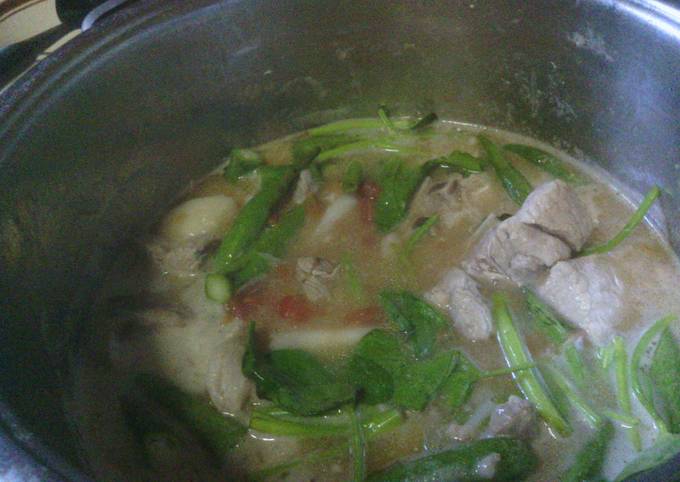Easiest Way to Make Tasty Pork Rib Sinigang
Pork Rib Sinigang. Pork ribs, pork belly, pork butt, and pork shoulder are the recommended cuts for sinigang. My personal favorite is pork ribs as it makes a wonderfully rich broth that goes so well with the sour flavor. Sinigang na Baboy Ingredients These are the essential ingredients to make sinigang.
 Turn the pork occasionally, until browned. I prefer to use either pork belly or buto-buto when cooking sinigang. The latter refers to cuts with bones intact. You can have Pork Rib Sinigang using 15 ingredients and 13 steps. Here is how you cook that.
Turn the pork occasionally, until browned. I prefer to use either pork belly or buto-buto when cooking sinigang. The latter refers to cuts with bones intact. You can have Pork Rib Sinigang using 15 ingredients and 13 steps. Here is how you cook that.
Ingredients of Pork Rib Sinigang
- It's of Pork Ribs.
- It's of Kangkong Leaves (river spinach, water spinach, swamp cabbage).
- You need of Labanos (radish).
- You need of Gabi (taro root).
- Prepare of Okra (lady's fingers or gumbo).
- Prepare of Tomato.
- You need of Red Onion (Bermuda Onion).
- Prepare of Salt.
- You need of Patis (fish sauce).
- It's of Option 1 Tamarind Stock (Instant).
- It's of Knorr Sinigang Mix (44 grams).
- Prepare of Hot Water.
- You need of Option 2 Tamarind Stock (Natural).
- You need of Tamarind.
- You need of Water.
These are either pork neck bones, chopped spare ribs, and chopped baby back ribs. Pork shoulder and ham can also be used when cooking sinigang. Great recipe for Pork Rib Sinigang. Sinigang is a traditional Filipino dish whose ingredients are normally substituted depending on the preference of each household; or which region of the Philippines you are in.
Pork Rib Sinigang instructions
- OPTION 1 TAMARIND STOCK: If using the instant tamarind stock, dissolve half of the packet of Knorr Sinigang Mix into 3 cups of hot water. Set aside..
- OPTION 2 TAMARIND STOCK: If using the natural tamarind stock, you would have to prepare it before starting with the main dish. Wash thoroughly and then boil the large tamarinds in 2 cups of water over medium heat until very tender. Make sure to cover the pot to avoid the water from evaporating; and when it does, just add half cups at a time. Once tender, remove the tamarind from the pot and set aside for awhile. Get a large metal strainer and put it over the pot where you boiled the tamarind. Put the tamarind on the strainer and squeeze the juice into the pot. Do not worry about the shells as they would easily break with the pressure applied during squeezing. Once the tamarind juice is thoroughly extracted, discard the shell and seeds from the strainer. Set aside the tamarind stock. It would be best for you to prepare extra stock so you can use it to enhance flavor if you wish to increase the amount of soup..
- PREPARATION 1: Slice the meaty parts of the pork ribs into cubes and leave the bony parts the way they are..
- PREPARATION 2: Wash and detach the kangkong leaves from the stalk. You may slice the soft parts off the stalk but make sure to leave out the hard parts..
- PREPARATION 3: Wash, peel and slice the labanos crosswise to make flat round pieces. Wash and slice the okra crosswise to make cylindrical pieces..
- PREPARATION 4: Wash, peel and slice the gabi into large cubes..
- PREPARATION 5: Slice the tomatoes into quarters or eighths, whichever suits you for sauteing; and dice the onions..
- Saute the pork in tomatoes and onions. Allow the surface of the pork to cook, constantly mixing until the tomatoes are soft and the onion is clear..
- Add the tamarind stock into the sauteed pork. Mix thoroughly and cover. Allow the pork to cook completely until tender..
- Add the gabi, labanos and okra. Cook until the gabi and okra are tender and the labanos is clear. To prevent the stock from drying up, add half cups of water at a time..
- Enhance the flavor through adding the left-over sinigang mix or extra tamarind stock. Balance the flavor out using salt or patis. The natural taste of the soup is flavorfully sour, so it is best to add the remaining sinigang mix or tamarind stock gradually for you to capture what suits your taste well..
- Finally, pitch in the kangkong leaves and let it simmer for 2 to 3 minutes in low fire. Do not overcook the kangkong by putting it in the soup longer. Remember that it cooks some more even after putting the pot out of the fire..
- Enjoy the dish with steamed rice; and this dish could also be nicely paired up with "lechon kawali" (deep fried pork belly)..
The sinigang I am publishing is the kind that my mother always cooks us at home. Add pork ribs to the pot and stir to combine with aromatics. Put tamarind pulp in a fine. Sinigang na Baboy is the ultimate comfort food! Made with pork ribs, vegetables, and tamarind-flavored broth, it's hearty and delicious on its own or served with steamed rice.
Comments
Post a Comment